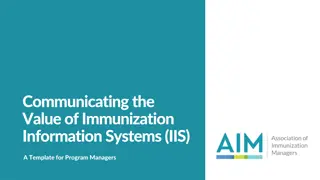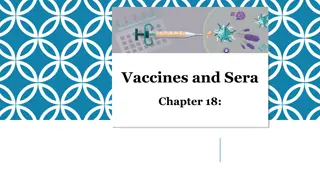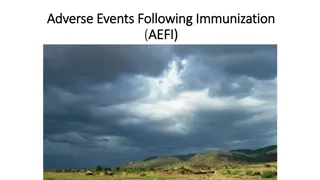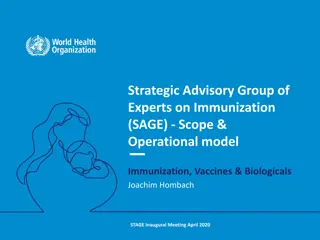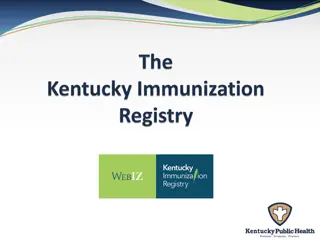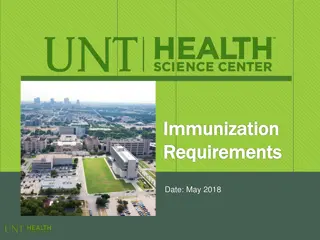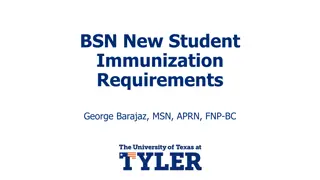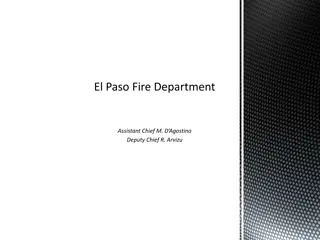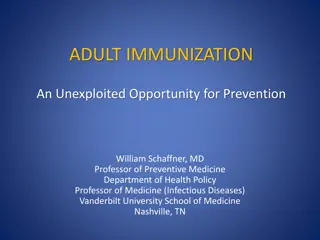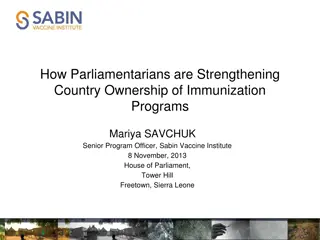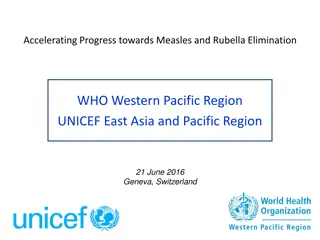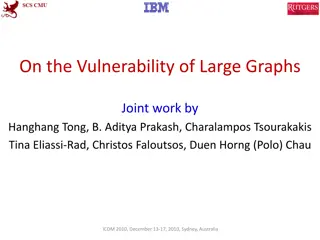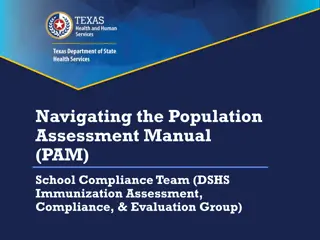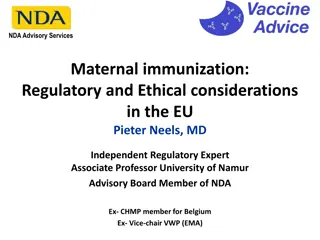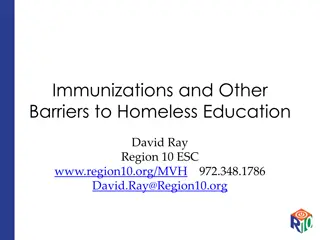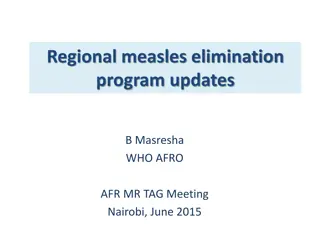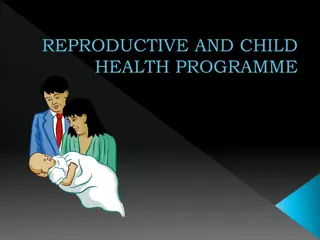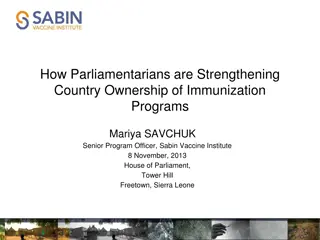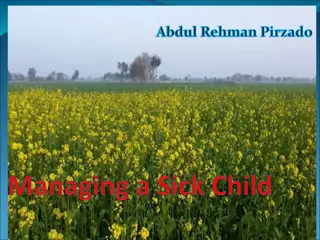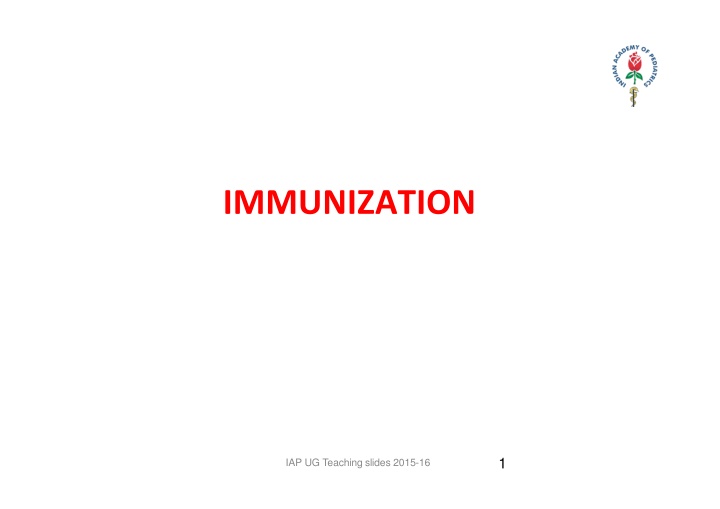
Vaccine Immunology and Administration Techniques
Explore the basics of vaccine immunology, types of vaccines, response after immunization, and determinants of immune response. Learn about active immunization, different vaccine categories, and factors affecting immune response to vaccines. Discover the techniques and considerations for administering vaccines effectively.
Download Presentation

Please find below an Image/Link to download the presentation.
The content on the website is provided AS IS for your information and personal use only. It may not be sold, licensed, or shared on other websites without obtaining consent from the author. If you encounter any issues during the download, it is possible that the publisher has removed the file from their server.
You are allowed to download the files provided on this website for personal or commercial use, subject to the condition that they are used lawfully. All files are the property of their respective owners.
The content on the website is provided AS IS for your information and personal use only. It may not be sold, licensed, or shared on other websites without obtaining consent from the author.
E N D
Presentation Transcript
IMMUNIZATION 1 IAP UG Teaching slides 2015-16
OVERVIEWS Basic vaccine immunology Vaccination technique National immunization program (NIP), IAP Schedule Individual vaccines 2 IAP UG Teaching slides 2015-16
ACTIVE IMMUNIZATION Administration of all or part of microorganism or a modified product to stimulate immune response mimicking natural infection without risk to the recipient 3 IAP UG Teaching slides 2015-16
TYPES OF VACCINES Live attenuated: BCG,OPV, measles, varicella Killed / inactivated: Whole cell : Hepatitis A, Rabies, whole cell pertussis (wP) Subunit : Hepatitis B, acellular pertussis (aP) Toxoid : Tetanus, diphtheria Protein conjugated : Hib conjugate, pneumococcal conjugate Polysaccharide : Typhoid (Vi),Pneumococcal polysaccharide 4 IAP UG Teaching slides 2015-16
RESPONSE AFTER IMMUNIZATION PROTEIN VS POLYSACCHARIDE VACCINES Protein antigens stimulate T cells in lymph nodes. large quantity of high affinity antibodies are formed. Memory cells are formed which produces a more and higher antibody response on re exposure rapid Polysaccharide antigens are T cell independent; limited antibodies of lesser affinity are formed No memory cells are produced so no booster effect on reexposure to same antigen. 5 IAP UG Teaching slides 2015-16
RESPONSE TO VACCINES Live vaccines Multifocal lymph node activation Better immunogenecity Less number of doses May provide life long immunity after single dose itself Killed vaccines Usually stimulate regional lymph nodes Needs repeated doses to maintain optimum antibody level Adjuvants may be added to increase immunogenicity 6 IAP UG Teaching slides 2015-16 6
DETERMINANTS OF IMMUNE RESPONSE Type of vaccine: Live Vs inactivated Protein Vs polysaccharide Vaccine schedule: Adequate interval between priming doses; optimal interval between priming and boosting doses Age: Immunologic immaturity and interference by maternal antibody in early life. 7 IAP UG Teaching slides 2015-16
TECHNIQUE OF VACCINE ADMINISTRATION Hands to be cleaned Separate needle and syringe for each injection Discard needle and syringe safely Avoid gluteal region for IM injection Gentle pressure at vaccination site for a few seconds after vaccination 8 IAP UG Teaching slides 2015-16
Open plunger sideCorrect dose Wash hands Safe disposal Correct site 9 IAP UG Teaching slides 2015-16
TECHNIQUE OF VACCINE ADMINISTRATION Type of Vaccine Measles, MMR, Varicella Needle size Route Site Outer triceps area ( Posterior skin fold) 23-25 G, 5/8 Subcutaneous DPT, TT, Td, DTaP, Hep B, Hib, PCV, Hep A 22-25 G 1-2 IM Deltoid, vastus lateralis ( antero lateral thigh ) BCG given intradermally over deltoid region 1 0 IAP UG Teaching slides 2015-16
COLD CHAIN The cold chain is the system of storing and transporting vaccines at recommended temperatures from the point of manufacture to the point of use. Safe zone for short term storage: 2 Cto 8 C Equipment for cold chain maintenance: ILR/Refrigerator/Vaccine carrier Temperature monitoring devices 11 IAP UG Teaching slides 2015-16 11
DOMESTIC REFRIGERATOR AND VACCINE STORATGE 1 2 IAP UG Teaching slides 2015-16
VACCINE VIAL MONITOR (VVM) The combined effect of time and temperatur cause the inner square of the VVM to darken gradually & irreversibly. e 13 IAP UG Teaching slides 2015-16
THERMOSENSITIVITY OF VACCINES HEAT SENSITIVE BCG(recon.) OPV MEASLES BCG DPT DT,TT,HBV,JE Most Least 14 IAP UG Teaching slides 2015-16
FREEZE SENSITIVE Aluminum adjuvanted vaccines should not be frozen. If frozen it desiccates, leads to decrease in potency and causes sterile abscess.eg. Hep B, Tseries vaccines, Hib. Hep B most freeze sensitive, freezes at 0.50C DPT, TT ,DT freezes at 30C. Do not keep these vaccines on ice pack. Ice pack temp. 200C so condition it before using. 15 IAP UG Teaching slides 2015-16
FREEZE DAMAGE Shake test Conditioned ice pack 16 IAP UG Teaching slides 2015-16
POLICY REGARDING MULTIDOSE AND RECONSTITUTED VACCINES Opened reconstituted multi dose vials of measles and BCG vaccines must be discarded at the end of each immunization session or at the end of 4 hours whichever is earlier Opened multi dose vials of DPT, TT, Hepatitis B and OPV vaccines may be used in subsequent immunization sessions up to a maximum of 1 month provided that the vaccines have been stored properly and the expiry date has not passed 17 IAP UG Teaching slides 2015-16
CONTRAINDICATIONS FOR VACCINATION Anaphylaxis following a previous dose or known allergic reaction to vaccine component Encephalopathy within 7 days of pertussis vaccine For some live vaccines immuno suppressed state Minor illnesses are not contraindications 18 IAP UG Teaching slides 2015-16
ADVERSE EVENTS FOLLOWING IMMUNIZATIONS (AEFI) An untoward event following immunization that might or might not have been caused by immunization Types of adverse events: Vaccine reaction Immunization error Anxiety reaction Coincidental Serious AEFI: Death, disability, hospitalization 19 IAP UG Teaching slides 2015-16
NATIONAL IMMUNIZATION SCHEDULE 1978: EPI ( Expanded program of immunization) India introduced 6 vaccines BCG, DPT, OPV, DT, TT, 1985: UIP (Universal immunization program) Targeted to immunize all infants with BCG, OPV, DPT and measles and TT for pregnant women Pulse polio program ( National Immunization Day) Hepatitis B is given only in some states currently 20 IAP UG Teaching slides 2015-16
NATIONAL IMMUNIZATION SCHEDULE Birth 6 weeks 10 weeks 14 weeks 9-12 months 16-24 months 5-6 years 10 years 16 years BCG, OPV, Hep B1 DTwP1, OPV1, HepB2,Hib* DTwP2, OPV2, HepB3,Hib* DTwP3, OPV3, HepB4, Hib* +IPV Measles / MR, JE1 DTwP B1, OPV4, Measles, JE2# DTwP B2, TT TT #JE vaccine given in select endemic districts *Hib vaccine is given as pentavac in select states 21 IAP UG Teaching slides 2015-16
PREGNANT WOMEN TT1 (early in pregnancy) TT2 (1 month later) TT booster (if vaccinated in past 3 years) Vitamin A 9months,18months then 6 monthly upto 5 yrs total 9 doses 22 IAP UG Teaching slides 2015-16
IAP IMMUNIZATION SCHEDULE Age (completed weeks/months/years) Vaccines Birth 6 weeks BCG,OPV 0, HepB 1 DTwP1,IPV1,Hib1,HepB2 Rotavirus1,PCV 1 10 weeks DTwP2,IPV2,Hib2, Rotavirus2,PCV 2 DTwP3,IPV3,Hib3, (Rotavirus 3),HepB3 PCV 3 14 weeks 9 months 9-12 months OPV2,MMR1 Typhoid conjugate vaccine 2 3 IAP UG Teaching slides 2015-16
IAP IMMUNIZATION SCHEDULE CONTD Age Vaccines 12 months Hepatitis A 15 months MMR2,Varicella,PCV Booster 16 to 18 months DTwP B1/DTap B1, IPVB1, Hib B1 Hepatitis A 2 18 months 2 years Typhoid 1 5 Years DTwP B2/DTaP B2,OPV3, Typhoid B,Varicella 2 Tdap/Td HPV 10 to 12 years 24 IAP UG Teaching slides 2015-16
INDIVIDUAL VACCINES Vaccines under national immunization program 25 IAP UG Teaching slides 2015-16
BCG VACCINE BCG is a live attenuated vaccine containing bovine tuberculosis bacilli Administered in the newborn period Protective against severe forms of child hood TB ( Miliary and meningeal TB) 50 80% efficacy Can even be given to babies of HIV positive mothers in newborn period 26 IAP UG Teaching slides 2015-16
BCG VACCINE ADMINISTRATION BCG is supplied as lyophilized powder in dark coloured multidose ampoules or vials ( to be protected from light) with diluent Reconstituted vaccine dose is 0.1ml: intradermal route over left deltoid region using tuberculin syringe and 26G/27G needle Following local reaction, scar formation occurs in 6 12 weeks 27 IAP UG Teaching slides 2015-16
ORAL POLIO VACCINE (OPV) 2 types of polio vaccines were developed in 1950 s: OPV by Albert sabin and IPV ( Inactivated polio vaccine Injectable) by Jonas Salk OPV is used in NIP and also on NIDs Contains attenuated polio virus types 1,2 and 3 Highly heat sensitive Immunogenicity less in developing countries; multiple doses required Monovalent OPV P1 or P3 ( MOPV) and bivalent OPV ( BOPV) P1 + P3 in some areas they are more immunogenic than trivalent OPV 28 IAP UG Teaching slides 2015-16
ORAL POLIO VACCINE OPV given at birth, 6, 10,14, weeks, 16 24 months under NIS Also in NIDs (Pulse polio) and SNIDs to break circulation of wild polio virus Orally 2 drops Type I 106Type II 10 5.5and Type III 105.5doses Extremely rare, but serious adverse effects of OPV: Vaccine associated paralytic polio (VAPP) Vaccine Derived polio viruses (VDPVs) 29 IAP UG Teaching slides 2015-16
DIPHTHERIA, TETANUS AND PERTUSSIS (WHOLE CELL) VACCINE DTWP Contains diphtheria and tetanus toxoids and killed pertussis bacilli 3 primary doses at 6, 10 and 14 weeks and 2 boosters at 16 24 months and 5 years Effectiveness: Diphtheria and tetanus > 95% ; pertussis 70 90% Tetanus boosters recommended at 10 and 16 years 30 IAP UG Teaching slides 2015-16
ADVERSE EVENTS FOLLOWING DTWP Minor adverse events like pain, swelling, redness at injection site, fever and irritability in about 50% of vaccines More serious adverse events are rare Absolute contraindications: Anaphylaxis to previous dose Encephalopathy within 7 days of DTP Progressive neurological deficit relative contraindication 31 IAP UG Teaching slides 2015-16
MEASLES VACCINE Live attenuated viral vaccine Supplied as lyophilised powder in dark coloured vials with diluent Reconstituted vaccine should be discarded after 4 hours Dose 0.5 ml: subcutaneous route Administered at 9 months of age 32 IAP UG Teaching slides 2015-16
HEPATITIS B VACCINE To prevent chronic HBs Ag carrier state which can lead to chronic liver problems and mortality in adults Available as recombinant HBs Ag ( Hepatitis B surface antigen) vaccine Dose: 0.5ml IM in <18 years of age ; 1ml in > 18 years Various schedules are effective ( >95% seroprotection) Birth, 1 mo and 6 mo (IAP) Birth, 6 wks, 14 wks Birth, 6 wks, 10 wks, 14 wks(NIS) 6 wks, 10 wks, 14 wks Birth dose necessary to prevent vertical transmission 33 IAP UG Teaching slides 2015-16
VACCINES NOT UNDER CURRENT NIP RECOMMENDED BY IAP 34 IAP UG Teaching slides 2015-16
MMR VACCINE Supplied in lyophilised form with diluent Each reconstituted dose of 0.5 ml contains live attenuated measles, mumps and rubella viruses Route of administration similar to measles vaccine, subcutaneous route IAP recommends 2 doses: 1st dose at 9 months of age 2nd at 15months of age 35 IAP UG Teaching slides 2015-16
HEMOPHILUS INFLUENZAE TYPE B ( HIB) VACCINE Hib important pathogen in invasive infections such as meningitis and pneumonia Hib vaccine is a conjugate vaccine; each 0.5ml contains capsular polysaccharide bound to a protein (tetanus toxoid or nontoxic mutagenic diphtheria toxoid) Dose 0.5ml IM Schedule recommended: 3 doses below 6 months of age starting at 6 weeks: minimum interval of 4 weeks between doses; booster at 15 18 month of age Efficacy 90 100% 36 IAP UG Teaching slides 2015-16
INACTIVATED POLIO VACCINE (IPV) Killed vaccine containing all the 3 types of polio virus; given by IM injection Sero conversion rates are 90 100% when given at 6,10 and 14 weeks; a booster dose recommended at 15 18 months of age IAP recommends combined sequential OPV , IPV schedule for best protection and also to reduce to risk of VAPP IPV is to be introduced as single dose at 14 weeks with OPV 37 IAP UG Teaching slides 2015-16
ACELLULAR PERTUSSIS VACCINE (AP) Instead of whole pertussis bacilli, some components like pertussis toxin, filamentous hemagglutinin and pertactin are included in the acellular DTaP vaccine Dose and age recommendations are similar to DTwP vaccine Minor and major side effects seen with DTwP are decreased by nearly 2/3 with DTaP Absolute contraindications are similar to DTwP Cost is a major factor DTwP is found to be more efficacious hence now DTwP recommended for primary vaccination series. 38 IAP UG Teaching slides 2015-16
TYPHOID VACCINE Vi Polysaccharide vaccine and conjugate typhoid vaccines are available. Vi polysaccharide 1st dose given after 2 years of age; To be repeated every 3. years Efficacy 65 75% Typhoid conjugate vaccine may be given at 9 months of age. 39 IAP UG Teaching slides 2015-16
VARICELLA VACCINE Chickenpox generally a benign disease in children complications in neonates, adolescents and adults, pregnant women and immuno compromised Varicella vaccine; live attenuated virus; lyophilised powder; to be reconstituted with the diluent Dose: 0.5ml; subcutaneous Currently 2 doses are recommended by IAP : 1st at 15 month of age 2nd between 4 6 years of age 40 IAP UG Teaching slides 2015-16
HEPATITIS A VACCINE Hepatitis infection is relatively benign in young children <5 years of age and may be asymptomatic in many Hepatitis A can be severe in adults and in those with underlying chronic liver disease Vaccine is formalin inactivated (killed); Dose 0.5ml IM Recently a live attenuated vaccine also available;1ml per dose IM IAP recommends 2 doses at 6 12 months interval; starting at > 1 year of age Protective efficacy 90 100% 41 IAP UG Teaching slides 2015-16
PNEUMOCOCCAL VACCINE S.pneumoniae important cause of death due to severe pneumonia and bacterial meningitis in children 2 Vaccines: 13 valent PCV (Pneumococcal conjugate vaccine) 23 Valent PSV (Pneumococcal polysaccharide vaccine) PCV is T cell dependant and immunogenic in children < 2 years PCV recommended by IAP for routine immunization 6,10, 14 weeks and booster 15 18 months; 0.5ml IM PSV in special groups after 2 years of age (sickle cell disease, asplenia, nephortic syndrome) 42 IAP UG Teaching slides 2015-16
ROTA VIRUS VACCINE ROTA virus major cause of severe diarrhea related mortality in developing countries 2 live attenuated oral vaccines available: Human monovalent vaccine ( 2 doses; 1ml each) Human bovine reassorted pentavalent vaccine ( 3 doses; 2ml each) Schedule: Ist dose 6 8 weeks (not later than 14 Wks) Interval between doses 4 8 weeks Complete last dose before 32 weeks 43 IAP UG Teaching slides 2015-16
RABIES VACCINE Rabies vaccines currently used are the modern tissue culture vaccines: Purified chick embryo cell vaccine (PCEV), Purified vero cell vaccine (PVCV), Human diploid cell vaccine (HDCV) Equal efficacy Post exposure prophylaxis started as soon as possible Standard protocol (Essen): Days 0,3,7,14 and 30 Dose: 1ml IM ; anterolateral thigh or deltoid muscle ID route Updated Thai red cross regime 2 2 2 0 2 0 44 IAP UG Teaching slides 2015-16
JAPANESE ENCEPHALITIS (JE) VACCINE JE risk is highest in children aged 1 15 years and in rural areas Cell culture derived live SA 14 14 2 Chinese vaccine Dose 0.5ml subcutaneous, 2 dose 9 months and 18months Given to children aged 1 15 years in selected districts of UP, Assam, West Bengal, Kerala and Karnataka 45 IAP UG Teaching slides 2015-16
HUMAN PAPILLOMA VIRUS (HPV) VACCINE Vaccine for prevention of cervical cancer HPV types 16 and 18 are responsible for 70% of cervical cancer worldwide, including India 2 vaccines available in India Quadrivalent (16,18,6,11) and Bivalent (16,18) vaccines Protective efficacy 93 99% IAP recommends routine HPV vaccination for girls at 10 12 years of age 3 doses : 0,2 and 6 months ( Quadrivalent) 0,1 and 6 months ( Bivalent) 46 IAP UG Teaching slides 2015-16
THE MYTHS AND FACTS ABOUT IMMUNIZATION The Myth Too many vaccines might overload the immune system The Fact The immune system can simultaneously respond to over 10 million antigens at any one time Natural infections present more antigens 47 IAP UG Teaching slides 2015-16
THE MYTHS AND FACTS The myth Combination vaccines may be less effective than vaccines administrated separately The fact The DTPw HB Hib combination formulations Excellent immunological response 48 IAP UG Teaching slides 2015-16
POINTS TO REMEMBER IMMUNIZATION Vaccines as per schedule as per chronological age in pre terms and low birth weight babies Need not restart even after lapse of usual interval Minor illnesses, malnutrition not contra indications 49 IAP UG Teaching slides 2015-16
POINTS TO REMEMBER IMMUNIZATION Minimum 4 weeks gap between 2 primary doses of the same vaccine. Minimum of 4 weeks gap between 2 live vaccines Killed vaccine can be given any time after or before any vaccine 50 IAP UG Teaching slides 2015-16

